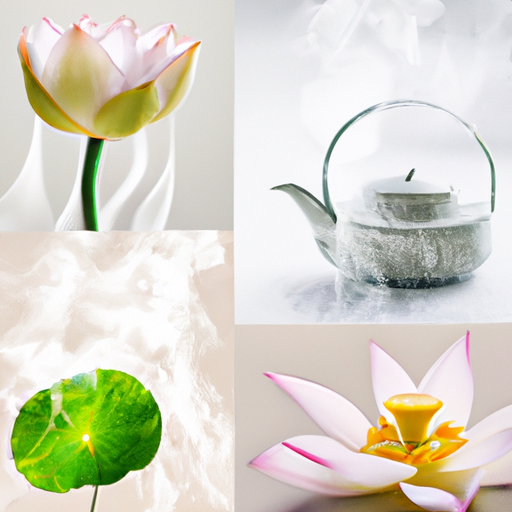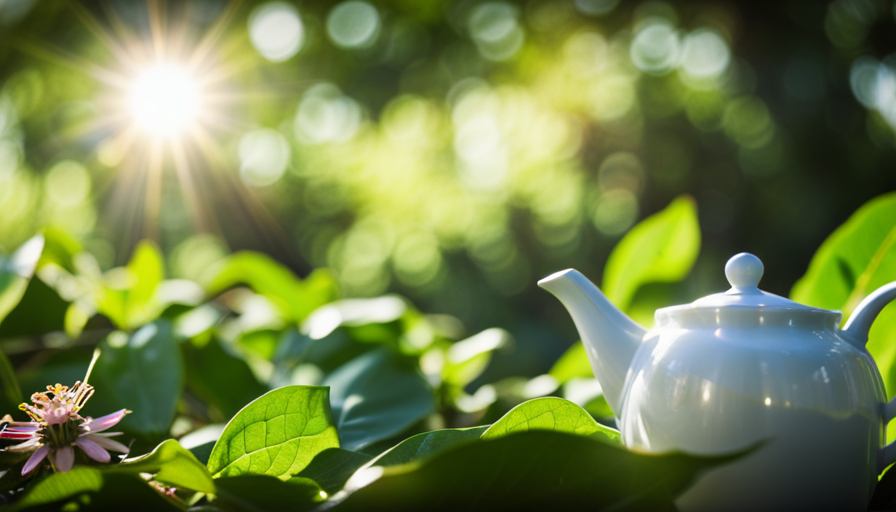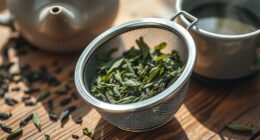Hey there, tea lovers! Have you ever wanted to try something truly unique and exotic? Well, I’ve got just the thing for you – lotus flower tea! This exquisite beverage is not only visually stunning but also packed with incredible health benefits. So, let me walk you through the process of making this delightful tea.
First things first, finding the right lotus flower is crucial. Remember, not all lotus flowers are suitable for making tea, so choose wisely. Once you’ve got your hands on the perfect bloom, it’s time to prepare it by gently removing the petals and discarding the center.
Next, boil some water and steep the lotus petals for a few minutes. This will infuse the water with a delicate floral aroma and a hint of sweetness. To enhance the flavor, you can add a touch of honey or lemon.
Finally, strain the tea into a cup and get ready to enjoy a soothing and refreshing experience like no other. Not only will you savor the unique taste, but you’ll also reap the incredible health benefits that lotus flower tea has to offer.
But wait, there’s more! Lotus flowers have many other uses beyond tea. From skincare to culinary delights, these versatile blossoms can add a touch of elegance to your everyday life.
So, why not embark on this enchanting journey and discover the wonders of lotus flower tea? Trust me, it’s a sip worth taking!
Key Takeaways
- Choosing the right lotus flower is crucial for making tea.
- Remove the petals and discard the center of the lotus flower.
- Add honey or lemon to enhance the flavor of the tea.
- Strain the tea into a cup for a soothing and refreshing experience.
Choose the Right Lotus Flower
When making lotus flower tea, it’s crucial to choose the right lotus flower for the best flavor and aroma. The key to a successful tea lies in the cultivation of the lotus flower itself.
Lotus flowers are known for their symbolic significance in various cultures, representing purity, enlightenment, and rebirth. To ensure the finest taste and fragrance in your tea, select lotus flowers that are fully bloomed and vibrant in color. These flowers possess a delicate balance of sweetness and bitterness, which adds complexity to the tea’s flavor profile. Additionally, the petals of the lotus flower are rich in essential oils, contributing to its unique aroma.
Now that we’ve chosen the perfect lotus flower, let’s move on to preparing it for our tea.
Prepare the Lotus Flower
To prepare the lotus flower for making tea, the first step is to remove the stamen and sepals. This is important because the stamen can add bitterness to the tea, while the sepals can have a strong and unpleasant taste.
Once the stamen and sepals are removed, the next step is to clean and wash the flower thoroughly to ensure that any dirt or impurities are removed. This will help to enhance the flavor and quality of the lotus flower tea.
Removing the Stamen and Sepals
First, carefully pinch the base of the lotus flower and gently twist it to remove the stamen and sepals, revealing the elegant petals. The stamen and sepals are the reproductive parts of the flower and aren’t needed for making lotus flower tea. Removing them allows us to focus on the beautiful and fragrant petals, which are the main ingredient in the tea.
Discussion ideas:
-
Health benefits of lotus flowers: Lotus flowers are known for their medicinal properties, such as promoting healthy digestion and reducing stress. They’re also rich in antioxidants, which help boost the immune system and fight off free radicals.
-
Different ways to prepare lotus flower tea: Lotus flower tea can be prepared by steeping the petals in hot water or infusing them with other herbs and spices for added flavor. Some people even use lotus flower tea as a base for cocktails or desserts.
Now that we’ve removed the stamen and sepals, let’s move on to cleaning and washing the flower.
Cleaning and Washing the Flower
After removing the stamen and sepals, the next step is to delicately cleanse and rinse the exquisite lotus petals.
Cleaning the petals is a crucial part of preparing lotus flower tea, as it ensures that any dirt or impurities are removed. To clean the petals, gently hold them under cool running water, allowing the water to wash away any debris. Be careful not to be too forceful, as the petals are delicate and can easily tear.
Once the petals are clean, pat them dry with a soft, clean towel. It’s important to make sure they’re completely dry before proceeding to the next step. This can be done by laying the petals out on a paper towel and allowing them to air dry for a few hours.
Now that the petals are clean and dry, they’re ready to be used to make the fragrant and refreshing lotus flower tea.
Boil Water and Steep the Tea
Once the water’s bubbling and the tea bag’s gently immersed, the magic starts to happen. The aroma of the lotus flower begins to fill the air, creating a delightful and calming ambiance.
As the tea steeps, it’s important to remember that there are different steeping techniques to enhance the aroma and flavor. Here are three techniques to try:
-
Short Steep: Steep the tea for 1-2 minutes for a light and delicate flavor.
-
Medium Steep: Steep the tea for 3-4 minutes for a balanced and aromatic cup.
-
Long Steep: Steep the tea for 5-6 minutes for a stronger and more robust taste.
By experimenting with these different steeping techniques, you can find the perfect balance of aroma and flavor that suits your preference.
Now, let’s move on to the next step and discover how to enhance the flavor of our lotus flower tea.
Enhance the Flavor
After boiling water and steeping the tea, it’s time to enhance the flavor of your lotus flower tea. This step is crucial in creating a delightful and aromatic beverage.
To enhance the aroma, I recommend adding a few slices of fresh ginger to the tea. The warm, spicy notes of ginger will complement the delicate floral flavors of the lotus flower, creating a harmonious blend of tastes.
Additionally, you can add natural sweeteners like honey or agave syrup to balance out any bitterness and add a touch of sweetness. Be mindful not to overpower the tea with too much sweetness, as it may mask the subtle flavors of the lotus flower.
Once you’ve enhanced the flavor to your liking, it’s time to move on to the next step: straining and serving the exquisite lotus flower tea.
Strain and Serve
To complete the process, strain and serve the fragrant lotus flower infusion, allowing its delightful flavor and aroma to envelop your senses.
Straining the tea is crucial to remove any loose petals or debris, ensuring a smooth and enjoyable drinking experience. I recommend using a fine mesh strainer to catch any small particles.
As you pour the tea into your cup, take a moment to appreciate the enchanting scent that fills the air, enhancing the aroma of this exquisite beverage.
If you prefer a sweeter taste, you can add a touch of honey or a sprinkle of stevia to enhance the natural sweetness of the lotus flower.
Now, let’s move on to the next step and discover the incredible health benefits that lotus flower tea can offer.
Enjoy the Health Benefits of Lotus Flower Tea
Lotus flower tea isn’t just a delicious beverage, but it’s also packed with numerous health benefits. Firstly, it promotes relaxation and reduces stress, making it the perfect choice for winding down after a long day.
Secondly, lotus flower tea is known for its immune-boosting properties, helping to strengthen the body’s defenses against illnesses.
Lastly, it’s a natural detoxifier, helping to eliminate toxins from the body and improve overall health.
So, sit back, sip on a cup of lotus flower tea, and enjoy the many health benefits it has to offer.
Promoting Relaxation and Reducing Stress
Imagine yourself sinking into a serene oasis as you sip on a cup of lotus flower tea, allowing its soothing properties to wash away your stress like a gentle wave. Lotus flower tea is renowned for its ability to promote relaxation and reduce stress, making it a perfect addition to your self-care routine.
Here are four ways in which this magical tea can help you achieve a state of tranquility:
-
Calming effects: Lotus flower tea contains natural compounds that have a calming effect on the nervous system, helping to alleviate anxiety and promote a sense of calm.
-
Stress reduction: The antioxidants found in lotus flower tea help to combat the effects of stress on the body, reducing inflammation and promoting overall well-being.
-
Improved sleep: Drinking lotus flower tea before bed can help to relax your mind and body, promoting a restful night’s sleep and reducing insomnia.
-
Mood enhancement: Lotus flower tea has been known to boost mood and enhance feelings of happiness, making it a wonderful choice for those seeking a natural way to improve their emotional well-being.
By incorporating lotus flower tea into your daily routine, you can experience the benefits of relaxation and stress reduction.
Next, we’ll explore how this incredible tea can also boost immunity and detoxify the body.
Boosting Immunity and Detoxifying the Body
Indulge in the power of this magical elixir and discover how it can strengthen your immune system and purify your body.
Lotus flower tea isn’t just a delicious beverage, but it also offers numerous health benefits. By boosting digestion, this tea helps your body absorb nutrients better and promotes overall gut health.
Additionally, the antioxidants present in lotus flowers can improve skin health, reducing the signs of aging and giving you a radiant complexion. The tea’s detoxifying properties help eliminate toxins from your body, leaving you feeling refreshed and rejuvenated.
So, sip on this delightful tea and let it work its wonders.
In the next section, we’ll explore other uses of lotus flowers, allowing you to further incorporate their benefits into your daily life.
Explore Other Uses of Lotus Flowers
Discover the hidden potential of these enchanting blossoms by exploring the various alternative uses for them. Lotus flowers have been used in traditional medicine for centuries, valued for their healing properties. In different cultures, lotus flower symbolism represents purity, enlightenment, and rebirth.
Here are some other fascinating uses of lotus flowers:
-
Lotus flower tea: Brewed from dried lotus flowers, this tea is known for its calming and stress-relieving properties. It can also aid digestion and promote healthy sleep.
-
Lotus flower essential oil: Extracted from the petals, this oil is used in aromatherapy for its soothing and uplifting effects. It can help reduce anxiety, improve mood, and enhance mental clarity.
-
Lotus flower in skincare: Lotus flower extracts are commonly used in skincare products for their hydrating and anti-aging properties. They can help rejuvenate the skin, reduce wrinkles, and promote a healthy glow.
By exploring these alternative uses of lotus flowers, you can experience their beauty and harness their many benefits.
Frequently Asked Questions
How long does it take for the lotus flower to bloom?
The blooming process of lotus flowers greatly affects their aroma and taste. It takes about 3-4 days for a lotus flower to fully bloom. The significance of lotus flowers varies across cultures, symbolizing purity, enlightenment, and rebirth.
Can I use any type of lotus flower to make lotus flower tea?
Sure, any type of lotus flower can be used to make lotus flower tea. However, it’s important to note that different types of lotus flowers have varying flavors and medicinal properties, making for a more diverse tea experience. Additionally, lotus flowers have alternative uses such as in culinary dishes or as a fragrant ingredient in perfumes.
What are some alternative ways to enhance the flavor of lotus flower tea?
To enhance the flavor of lotus flower tea, I recommend trying different tea brewing techniques. For example, you can experiment with longer steeping times or adding complementary ingredients like ginger or honey for a unique and delicious taste.
How many cups of lotus flower tea should I drink per day to enjoy its health benefits?
To enjoy the health benefits of lotus flower tea, I recommend drinking 2-3 cups per day. Lotus flower tea can be prepared by steeping dried lotus flowers in hot water for 5-10 minutes.
Are there any precautions or side effects associated with consuming lotus flower tea?
One interesting statistic about lotus flower tea is that it has been used for centuries in traditional Chinese medicine. When it comes to precautions and side effects, it’s important to note that lotus flower tea may cause allergic reactions in some individuals.
Conclusion
As I sip on a warm cup of lotus flower tea, I’m transported to a serene garden where beauty and tranquility reside. The process of making this delightful brew is as enchanting as the flower itself.
By carefully selecting the right lotus flower, preparing it with love and care, and steeping it in boiling water, you unlock a world of flavors and health benefits.
As the fragrant aroma wafts through the air, I’m reminded of the countless possibilities and wonders that nature has to offer. So, take a moment to indulge in this exquisite tea and let the lotus flower guide you on a journey of relaxation and rejuvenation.










